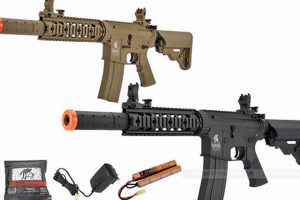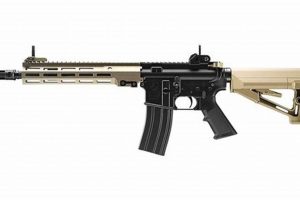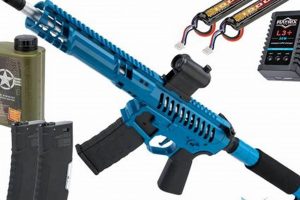Airsoft replicas constructed primarily of metallic materials offer a heightened level of realism and durability compared to their polymer counterparts. These models typically feature metal receivers, barrels, and internal components, contributing to a more substantial weight and feel. A common example includes replicas of popular firearm platforms utilizing metal alloys for external construction and reinforced gearboxes internally.
The utilization of metal in airsoft gun construction provides several advantages. The increased weight simulates real firearms, enhancing the training experience for military and law enforcement personnel. Metal construction is also more resistant to wear and tear from repeated use and environmental factors, leading to longer operational lifespans and reduced maintenance requirements. Historically, metal airsoft guns were considered a premium offering, reflecting a commitment to quality and realism in the sport.
The following sections will delve into specific aspects of selecting appropriate airsoft guns with substantial metal construction, including considerations for specific scenarios, internal components, and maintenance practices to ensure optimal performance and longevity.
Selection Guidance
The following guidelines offer insights into making informed choices when acquiring airsoft replicas with primarily metallic construction.
Tip 1: Assess Scenario Requirements: Determine the intended operational environment. CQB (Close Quarters Battle) scenarios might favor lighter, more maneuverable metallic airsoft guns, while outdoor engagements could benefit from heavier, more stable platforms capable of mounting optics and accessories.
Tip 2: Evaluate Metal Composition: Consider the specific metal alloys used in construction. Aluminum alloys offer a balance of strength and weight, while steel components increase durability in high-stress areas such as the gearbox and barrel assembly.
Tip 3: Inspect Internal Components: Prioritize models with reinforced internal components. A metal gearbox shell, metal gears, and a precision inner barrel contribute to enhanced performance and longevity, especially under sustained use or with higher-power upgrades.
Tip 4: Verify Hop-Up Unit Quality: The hop-up unit influences the trajectory and range of the BB. Ensure the chosen airsoft gun utilizes a durable and adjustable hop-up unit, preferably constructed of metal or a high-strength polymer, for consistent performance.
Tip 5: Consider Weight and Ergonomics: The weight of a metal airsoft gun can impact maneuverability and fatigue levels during prolonged gameplay. Evaluate the ergonomics of the rifle, including grip texture, stock adjustability, and accessory mounting options, to ensure comfortable handling.
Tip 6: Research Brand Reputation: Investigate the manufacturer’s reputation for quality and reliability. Read reviews and consult with experienced airsoft players to gauge the overall performance and durability of specific models.
Tip 7: Maintenance Schedules: Establish regular cleaning and maintenance schedules. Disassembling and lubricating internal components prevents corrosion, reduces friction, and extends the operational lifespan of the airsoft gun.
Adhering to these recommendations can facilitate the selection of a durable and reliable airsoft platform suitable for specific performance requirements and intended use.
The subsequent sections will address specific use-cases and maintenance strategies for optimal performance and longevity.
1. Durability and Longevity
The correlation between primarily metallic construction in airsoft replicas and their durability and longevity is a direct consequence of material properties. Metals, specifically steel and aluminum alloys commonly used in these platforms, exhibit superior resistance to physical stress, impact, and abrasion compared to polymers. This inherent resilience translates to a reduced likelihood of component failure under the stresses of regular use. For instance, a metal receiver is less prone to cracking or warping than a polymer counterpart when subjected to repeated impacts or the strain of mounted accessories.
The importance of enhanced durability extends beyond mere cosmetic preservation. Critical internal components, such as the gearbox shell and gears, benefit significantly from metal construction. A metal gearbox shell is less susceptible to cracking under the pressure generated by the spring and piston during firing, directly increasing the lifespan of the airsoft gun. Similarly, metal gears exhibit improved resistance to wear and stripping compared to plastic alternatives, particularly when used with higher-power springs. An example of practical significance lies in professional airsoft training scenarios. The greater durability of metal airsoft platforms reduces downtime due to repairs, ensuring consistent performance and minimizing disruption to training schedules.
In summary, metal construction contributes substantially to the durability and longevity of airsoft guns. The increased resistance to physical stress and wear reduces the likelihood of component failure, leading to a longer operational lifespan and reduced maintenance requirements. While metal construction may result in a higher initial cost, the increased durability often translates to a lower total cost of ownership over time. The selection of primarily metallic airsoft platforms should be viewed as an investment in reliable, long-lasting equipment.
2. Realistic Weight and Feel
The characteristic weight and tactile feedback of metallic airsoft replicas significantly enhance their realism, impacting both training simulations and recreational experiences. The substantial weight, mimicking actual firearms, provides a more authentic handling experience, improving user immersion and muscle memory development. This is particularly crucial in military and law enforcement training, where replicating the weight distribution and balance of service weapons contributes to more effective drills and skill transfer. The increased weight also often results in improved stability during aiming and firing, especially with larger platforms such as sniper rifles or support weapons. This enhanced stability allows for greater accuracy, especially in extended engagements or when engaging moving targets. For example, an airsoft M249 constructed with a significant amount of metal will more accurately simulate the weight and handling of the real-steel counterpart, thus becoming a more effective training tool.
Beyond purely functional aspects, the tactile experience of handling a metallic airsoft gun contributes significantly to the overall sense of realism. The cold, solid feel of metal surfaces provides a more authentic tactile feedback compared to the often lighter and more flexible feel of polymer materials. This heightened sensory input can improve user engagement and contribute to a greater sense of satisfaction. The realistic weight and feel also enhance the aesthetic appeal of airsoft replicas, making them more attractive to collectors and enthusiasts. The durability and visual appeal are tightly coupled. Airsoft replicas closely mimic the weight of corresponding real firearms, facilitating more realistic manipulation and weapon handling techniques. Replicas with realistic weight and feel add realism to simulations such as tactical scenarios that require real-world scenarios, further increasing the advantages.
In conclusion, the realistic weight and feel afforded by metal construction are integral components of airsoft platforms, enhancing the authenticity of both training simulations and recreational activities. The accurate weight distribution improves weapon handling and aiming stability, while the tactile feedback contributes to a more immersive and engaging experience. The correlation between these attributes and the overall quality and utility of airsoft guns is undeniable, making them a key consideration in the selection process.
3. Enhanced Performance Potential
The performance capabilities of airsoft replicas are intrinsically linked to their construction materials. Models featuring substantial metal components offer a distinct advantage in terms of enhanced performance potential, attributable to the increased durability and stability of these platforms. This allows for the implementation of higher-performance internal components and facilitates consistent operation under demanding conditions.
- Increased Power Handling
Metal receivers and gearboxes exhibit superior structural integrity, enabling them to withstand the stresses associated with higher-power springs and upgraded internal components. This allows for increased muzzle velocity and effective range compared to polymer-framed alternatives. The ability to handle increased power output directly translates to enhanced performance on the field, providing a competitive advantage in terms of range and impact force.
- Improved Accuracy and Consistency
Metal barrels, hop-up units, and other critical components contribute to improved accuracy and consistency. Metal barrels provide greater rigidity and resistance to vibration, resulting in more consistent BB trajectories. Metal hop-up units offer more precise adjustment and improved air seal, further enhancing accuracy. The combined effect of these factors leads to tighter groupings and more predictable shot placement.
- Greater Customization Options
Metal airsoft guns often offer a wider range of customization options compared to polymer models. Metal receivers typically feature standardized accessory rails, allowing for the attachment of optics, lights, lasers, and other tactical accessories. The ability to customize the platform to specific user preferences and mission requirements enhances its overall performance and utility.
- Enhanced Reliability and Durability under Stress
The inherent durability of metal components translates to improved reliability and performance consistency under prolonged use and demanding conditions. Metal gearboxes are less prone to cracking or warping under stress, ensuring consistent operation even with high-power upgrades. Metal barrels are more resistant to damage from impacts or mishandling, maintaining accuracy and performance over time. This enhanced reliability reduces downtime due to repairs and ensures consistent performance in challenging environments.
The enhanced performance potential afforded by metal construction translates to improved accuracy, increased power, and greater reliability. These advantages make metal airsoft platforms a preferred choice for serious players seeking a competitive edge. The ability to handle high-performance upgrades, maintain accuracy under stress, and withstand the rigors of demanding gameplay distinguishes metal airsoft guns as a premium option for discerning users.
4. Upgrade Compatibility
Metal airsoft replicas frequently present enhanced upgrade compatibility compared to their polymer counterparts. The robustness of metal receivers and internal components facilitates the installation of higher-performance parts without risking structural failure. Metal gearboxes, for instance, withstand stronger springs and more powerful motors, increasing muzzle velocity and rate of fire. The standardized dimensions and tolerances found in many metal airsoft guns ease the installation of aftermarket barrels, hop-up units, and other performance-enhancing components. A practical example involves replacing the stock gears with high-strength steel gears to withstand the stress of a more powerful motor, resulting in increased trigger response and sustained performance under heavy use. The compatibility extends to external accessories, where metal receivers often feature robust mounting points for optics, lasers, and other tactical equipment.
The upgrade compatibility influences the longevity and adaptability of the airsoft platform. Users can incrementally improve their airsoft gun’s performance and tailor it to specific roles or gameplay styles. This modularity provides cost-effectiveness, as the core platform can be retained while upgrading individual components as needed. For example, an initial investment in a base metal airsoft rifle can be augmented over time with a precision inner barrel for improved accuracy or a MOSFET unit for enhanced trigger response and battery protection. The interchangeability of components contributes to a broader support ecosystem, where a wide array of aftermarket parts and accessories are readily available. The selection of an airsoft replica with good upgrade compatibility can future-proof the investment, allowing it to adapt to changing performance requirements and user preferences.
In summary, the upgrade compatibility represents a significant advantage. Metal airsoft guns often provide increased robustness and standardized dimensions, allowing for easier and more effective customization. The increased resilience of these platforms supports the installation of high-performance internal and external components, enhancing performance and extending the lifespan of the airsoft gun. Metal constructed airsoft guns with a high degree of modification and adjustment can maintain its utility and performance.
5. Aesthetic Authenticity
Aesthetic authenticity represents a critical attribute in replicas, particularly airsoft guns constructed primarily of metallic materials. The close visual resemblance to real firearms enhances the user experience and adds value for collectors and enthusiasts. Metal construction facilitates replication of intricate details, surface finishes, and overall proportions, contributing to a high degree of realism. For example, the external appearance of an airsoft M4 replica with a metal receiver and barrel assembly can closely mirror that of its real firearm counterpart, including realistic markings, textures, and weathering patterns. The pursuit of aesthetic accuracy often drives manufacturers to utilize specialized finishing techniques such as anodizing, parkerizing, or Cerakote coatings to replicate the appearance and protective properties of real firearm finishes.
The importance of aesthetic authenticity extends beyond visual appeal. Accurate replication of firearm ergonomics and controls enhances the training value of airsoft replicas for military, law enforcement, and security personnel. Realistic weight, balance, and manipulation characteristics contribute to more effective training simulations and skill transfer. Furthermore, aesthetic authenticity fosters a sense of pride and ownership among airsoft enthusiasts, who appreciate the attention to detail and craftsmanship involved in creating realistic replicas. This attention to detail can also influence collector value; airsoft guns that accurately replicate rare or historically significant firearms often command higher prices on the secondary market. For example, an airsoft replica of a World War II-era rifle with accurate markings and period-correct features will be more highly valued than a generic or inaccurate representation.
The demand for aesthetic authenticity presents challenges for manufacturers. Replicating real firearm designs and markings may require licensing agreements or adherence to intellectual property regulations. The use of certain materials or finishes may be restricted by environmental regulations or import/export controls. Despite these challenges, the pursuit of aesthetic authenticity remains a driving force in the development and marketing of metal airsoft guns. The visual realism enhances the user experience, improves training effectiveness, and contributes to the overall value and collectability of these replicas. The increasing sophistication of manufacturing techniques and the growing demand for accurate representations of real firearms will likely continue to drive advancements in aesthetic authenticity.
6. Scenario Suitability
The selection of airsoft platforms is directly dictated by the intended operational environment. Metallic airsoft guns present distinct advantages and disadvantages contingent upon the specific scenario of use. Considerations such as weight, maneuverability, and rate of fire become paramount when evaluating suitability for various gameplay styles.
- Close Quarters Battle (CQB)
CQB environments, characterized by confined spaces and rapid engagements, necessitate maneuverability and rapid target acquisition. While metallic airsoft guns offer durability, their increased weight can impede movement in tight spaces. Shorter barrel lengths and lighter metal alloys, such as aluminum, are preferable in CQB scenarios. High rates of fire are advantageous for suppressive fire and engaging multiple targets quickly.
- Outdoor Field Play
Outdoor field play, involving larger engagement distances and varied terrain, emphasizes range, accuracy, and durability. Metallic airsoft guns with longer barrels and heavier metal alloys, such as steel, provide enhanced stability and accuracy at longer ranges. The increased weight is less of a hindrance in outdoor environments and contributes to recoil mitigation. The ability to mount optics and accessories, facilitated by metal receivers, is beneficial for long-range engagements.
- MilSim (Military Simulation)
MilSim events prioritize realism and authenticity, demanding airsoft platforms that closely replicate real-world firearms. Metallic airsoft guns offer superior aesthetic realism and durability, aligning with the demands of MilSim scenarios. Weight and handling characteristics that mimic real firearms enhance the training value of MilSim events. The ability to customize the platform with realistic accessories and tactical gear further contributes to the immersive experience.
- Target Shooting and Plinking
Target shooting and plinking applications focus on accuracy and repeatability. Metallic airsoft guns, with their rigid construction and enhanced accuracy potential, are well-suited for these activities. Consistent trigger pull and stable platforms contribute to tighter groupings. The ability to adjust hop-up and other settings allows for fine-tuning performance for specific target distances and environmental conditions.
The appropriate selection is intrinsically tied to the intended usage. A lightweight metal pistol is ideal for CQB scenarios and a heavy metal sniper rifle excels in outdoor gameplay and realism to MilSim events. Understanding individual needs is critical in selecting a model with suitable characteristics.
7. Maintenance Requirements
The operational longevity and consistent performance of airsoft guns constructed primarily of metal are directly contingent upon adherence to rigorous maintenance protocols. The inherent durability of metallic components does not negate the necessity for regular inspection, cleaning, and lubrication. The increased weight and complexity of metal mechanisms, compared to polymer alternatives, necessitate more diligent maintenance practices to prevent degradation and ensure reliable function. A failure to maintain metal components can result in corrosion, increased friction, and eventual mechanical failure. For example, neglecting to lubricate the metal gears within the gearbox assembly can lead to accelerated wear, reduced efficiency, and potential gear stripping, rendering the airsoft gun inoperable. The selection of appropriate cleaning solvents and lubricants is also critical, as incompatible products can damage seals, degrade metal finishes, or impede the movement of internal components.
The environmental conditions in which the airsoft gun is used significantly influence maintenance requirements. Exposure to moisture, dust, or extreme temperatures necessitates more frequent cleaning and lubrication. For instance, operating a metal airsoft gun in a humid environment increases the risk of corrosion, requiring the application of protective coatings or frequent cleaning to prevent rust formation. Similarly, exposure to fine dust particles can contaminate the gearbox assembly, increasing friction and accelerating wear. The proper disassembly and reassembly of metal airsoft guns require specialized tools and technical knowledge. Improper handling can damage delicate internal components or compromise the structural integrity of the platform. Many manufacturers provide detailed maintenance guides or videos to assist users in performing routine maintenance procedures. Seeking guidance from experienced airsoft technicians or professional gunsmiths can be beneficial for complex repairs or modifications.
In summary, comprehensive maintenance is not an optional consideration but an integral component of owning a metal airsoft gun. Regular cleaning, lubrication, and inspection are essential for maximizing performance and extending the operational lifespan. Proper maintenance requires a commitment to acquiring the necessary tools, knowledge, and materials. Addressing maintenance needs diligently translates to a longer operational life, reduced repair costs, and consistently higher performance. Neglecting preventative care, irrespective of initial quality or brand, guarantees accelerated wear. Consistent maintenance is a critical consideration and is directly linked to the long-term value and reliability of all-metal constructed airsoft guns.
Frequently Asked Questions about Airsoft Guns with Substantial Metal Construction
The following questions and answers address common concerns and misconceptions regarding airsoft platforms constructed primarily of metallic materials.
Question 1: Are all airsoft guns marketed as “full metal” actually constructed entirely of metal?
No. The term “full metal” is frequently used in marketing materials to denote airsoft guns with a significant proportion of metal components, but it does not guarantee that every part is metallic. Typically, the receiver, barrel, and certain internal components are metal, while smaller parts or accessories may be polymer. A thorough inspection of the specifications and product descriptions is recommended to ascertain the precise composition of individual components.
Question 2: Do metal airsoft guns offer inherently superior performance compared to polymer models?
Not necessarily. While metal construction enhances durability and allows for higher-power upgrades, performance depends on the quality of internal components, such as the gearbox, hop-up unit, and barrel. A well-designed polymer airsoft gun with high-quality internal parts can often outperform a poorly constructed metal model. Metal components can withstand forces better, making high-performance parts better able to operate effectively.
Question 3: Are metal airsoft guns legal in all jurisdictions?
Regulations governing the ownership and use of airsoft guns vary significantly by jurisdiction. Some areas may restrict the possession of realistic-looking replicas or require specific markings to distinguish them from real firearms. It is imperative to research and comply with all applicable laws and regulations in the relevant jurisdiction before purchasing or using metal airsoft guns.
Question 4: How does the weight of a metal airsoft gun affect gameplay?
The increased weight of metal airsoft guns can impact maneuverability and fatigue levels during prolonged gameplay. While the realistic weight enhances the training experience and improves stability, it can also make the platform more cumbersome to carry and handle. The trade-off between realism and maneuverability is a crucial consideration when selecting a platform.
Question 5: What are the primary maintenance requirements for metal airsoft guns?
Metal airsoft guns require regular cleaning, lubrication, and inspection to prevent corrosion, reduce friction, and ensure reliable operation. Disassembling and cleaning the gearbox, lubricating the gears, and applying protective coatings to metal surfaces are essential maintenance tasks. The frequency of maintenance depends on the usage environment and the intensity of gameplay.
Question 6: Are metal airsoft guns more expensive than polymer models?
Metal airsoft guns typically command a higher price point than polymer models due to the increased cost of materials and manufacturing processes. The enhanced durability and upgrade potential of metal platforms often justify the higher initial investment for serious players seeking long-term value.
The selection of a model requires carefully balancing a number of factors. Quality materials, excellent performance, and a long operational life are all essential characteristics.
The subsequent section will delve into specific brand and model recommendations based on various performance criteria and budget considerations.
Conclusion
The preceding analysis has elucidated the multifaceted attributes associated with airsoft guns incorporating substantial metal construction. Attributes examined encompass durability, realism, performance potential, upgrade compatibility, aesthetic authenticity, scenario suitability, and maintenance protocols. The assessment underscores the advantages and disadvantages inherent in employing metal in airsoft platform design, emphasizing the critical role of informed decision-making in the selection process.
The considerations outlined serve as a foundation for discerning consumers. Prudent evaluation of individual performance requirements, budgetary constraints, and intended use cases remains paramount. Continuing advancements in materials science and manufacturing techniques promise further refinement in the design and construction of durable and realistic airsoft platforms.







